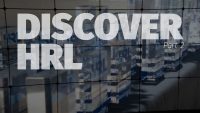Displaying news tagged: HRL Laboratories
HRL Laboratories Creates World’s First X-Band N-Polar GaN MMIC

The New Monolithic Microwave Integrated Circuit Promises Disruptive Improvements in Radar, Communications, and Electronic Warfare
HRL Podcast E06 | Heiko Hoffmann

At the time of this interview, Dr. Hoffmann was manager of the Autonomous Intelligence Department within the Information and Systems Sciences Laboratory of HRL Laboratories, known here as ISSL.
Discover HRL – Part 2

HRL Laboratories give out The HRL Awards every year to honor employees who have excelled in their positions in science, technology, engineering, administration and support. The opportunity to win an award is just one of the reasons people love working at HRL. In this video they talk about more!
Discover HRL – Part 1

Meet our DEI Specialist, Tess, who talks about a few of the highlights HRL Laboratories has to offer.
New Approach Enables Unprecedented Detail for 3D Microprinted Parts

HRL Laboratories, LLC’s additive manufacturing team has demonstrated 3D-printed polymer interposers with previously impossible slanted and curved vias with diameters of less than 10µm. Vias are small openings in the insulating layers of integrated circuits that allow conductive connections between semiconductor layers.
HRL Laboratories Research Scientist Selected for Frontiers of Engineering Symposium

HRL Laboratories, LLC, announced that Aruna Jammalamadaka, a research staff scientist in HRL’s Information and Systems Sciences Lab, was the latest HRL researcher to join other early-career engineers selected to take part in the National Academy of Engineering’s 26th Annual US Frontiers of Engineering Symposium, this year conducted virtually.
HRL Laboratories Sets Sights on Next-Generation Defense Electronics With Advanced Semiconductor Material
HRL Laboratories scientists are aiming for a disruptive improvement in radar, electronic warfare, and communications capabilities they hope will be enabled by their new project. If they are successful, the W-band, nitrogen-polar gallium nitride low-noise amplifier could be the world’s first such device, launching a new generation of defense-oriented electronics applications with a possible improvement of 4 times the output power in W bands over HRL’s existing technology.
Synergies: HRL Laboratories Collaborates with University of Minnesota to Test Graphene Devices

Professor Steve Koester of the University of Minnesota came to HRL Laboratories in Malibu, California to access specialized testing equipment. HRL is collaborating with the University of Minnesota on graphene varactors, devices used in artificial impedance surface antennas.
HRL Laboratories Celebrates 60th Anniversary of First Laser

On May 16, 1960, Theodore Maiman, researcher for Hughes Aircraft Corporation, activated the world’s first laser at the company’s brand new research facility in Malibu, California. HRL will celebrate the 60th anniversary of Maiman’s laser on May 16, 2020, 60 years and a few months after the opening of the site.
Diamond Electronics Will Take On the Heat

HRL Laboratories, LLC, electrical engineers have published an advancement on their diamond fin field-effect transistor (FinFET), a device that promises to enable future electronics that operate in high-temperature environments beyond the limits of current technology.